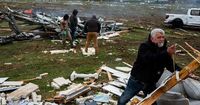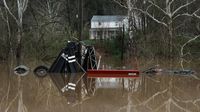Severe weather and flash flooding have wreaked havoc across parts of the United States, claiming at least 17 lives and leading to widespread destruction. As of Sunday, April 6, 2025, relentless storms have produced more than 90 tornadoes across ten states, with particularly devastating impacts in Kentucky, Tennessee, and Arkansas.
In Kentucky, a 9-year-old boy tragically lost his life after being swept away by floodwaters while walking to a bus stop. In total, the state has reported at least two fatalities due to the catastrophic flooding, which has left over 500 roads closed. The storm system has dumped torrential rain, with some areas receiving over a foot of rain, resulting in historic flooding.
The Arkansas Division of Emergency Management confirmed that a 5-year-old child died in southwest Little Rock due to weather-related incidents. In Missouri, a 16-year-old firefighter tragically died in a vehicle accident while responding to a water rescue, adding to the overall toll of the severe weather.
As the storms continued into Sunday, flood alerts stretched from Louisiana to western Pennsylvania, impacting major cities such as Atlanta, Nashville, and Memphis. The National Weather Service (NWS) issued a flash flood emergency for Memphis, where the city recorded over 12 inches of rain, marking its wettest-ever April day.
"Tonight is a fire chief's worst nightmare," said Beaufort-Leslie Fire Protection District Chief Terry Feth, mourning the loss of the young firefighter. The situation remains dire, with the Tennessee Emergency Management Agency (TEMA) warning of ongoing severe weather threats, particularly in southwest Tennessee. The agency noted the possibility of tornadoes and damaging winds exceeding 75 mph.
In Arkansas, emergency management officials reported multiple water rescues ongoing in areas heavily impacted by flooding. Preliminary damage reports indicated significant flooding on roadways, downed trees, and power lines. The NWS has warned that many rivers are expected to reach major flood stages, with at least 18 gauges currently reporting major flooding from Arkansas to Indiana.
Louisville Mayor Craig Greenberg stated, "We expect this to be one of the top 10 flooding events in Louisville history," as the Ohio River rose 5 feet in just 24 hours. Flooding has also led to significant disruptions in transportation, with over 521 flights canceled and more than 6,400 delayed across the country.
The storms have been fueled by warm temperatures and an unstable atmosphere, with meteorologists predicting that conditions could lead to additional severe weather in the coming days. The extreme weather has prompted concerns about shipping and supply chain disruptions, particularly affecting major cargo hubs in Louisville and Memphis.
As communities across the affected states continue to grapple with the aftermath of the storms, residents are urged to stay alert and take precautions against rising waters. Many are preparing for the possibility of more flooding as weather forecasts indicate additional rain through the weekend.
In Dyersburg, Tennessee, residents have sought refuge in storm shelters as they brace for the next wave of storms. "We have a lot of bad weather coming still," warned Michael Mueller, the county judge in Franklin County, emphasizing the dangers posed by the ongoing severe weather.
As the situation evolves, officials remain vigilant, urging residents to heed warnings and stay informed about the potential for further flooding and severe storms. With many rivers not expected to crest until mid-next week, the threat is far from over, and communities are left to pick up the pieces in the wake of this devastating weather event.
In summary, as of April 6, 2025, the storms have resulted in at least 17 confirmed fatalities, with ongoing severe weather warnings and flood emergencies across multiple states. The full extent of the damage is still being assessed, but the impacts on infrastructure, transportation, and communities are significant and likely to continue as the weather system moves eastward.







